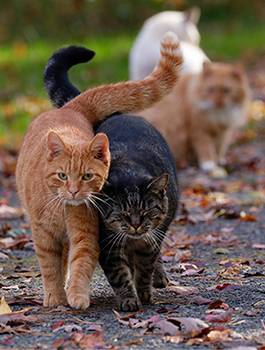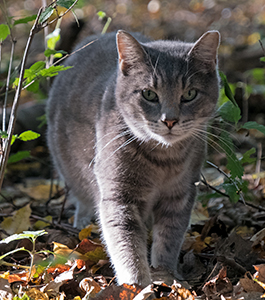No matter where you are, community cats probably live among you. Community cats are unowned cats who live outdoors in virtually every landscape on every continent where people live. Like pet cats, they belong to the domestic cat species (Felis catus). However, community cats, also known as feral, stray, or alley cats, are generally not socialized, or friendly and able to live indoors, with people. They live full, healthy lives with their feline families (called colonies) in their outdoor homes. Trap-Neuter-Return (TNR) is the only humane, effective approach to community cats, and it helps them and the communities where they live.

Community Cats are at Home Outdoors
Cats living outdoors is nothing new. For most of their natural history, cats have lived outside alongside people. Evidence shows cats began living near people over 10,000 years ago, before the pyramids were built! It wasn’t until very recently, with the invention of kitty litter in the 1940s, that so many cats began living indoors only. Community cats are truly at home outdoors, just as countless cats have been for thousands of years.
Learn more about the History of Cats
Community Cats are Healthy
Community cats thrive in their outdoor homes. They are used to living outdoors and are naturally skilled at finding shelter and food all on their own. Studies show community cats are just as healthy as pet cats, with equally low disease rates. Community cats also live just as long as pet cats. Learn more: Cats Living Healthy Lives Outdoors
Community Cats are Safe Members of the Community
Community cats are not a threat to public health. Since community cats aren’t friendly to people and avoid contact, it is almost impossible for them to transmit diseases. Science shows community cats don’t spread diseases like rabies and toxoplasmosis, and cats rarely carry germs that make people sick. Learn more about cats and public health
Community Cats Have a Place in the Natural Environment
Cats have coexisted outdoors with wildlife for thousands of years. Reliable science shows that cats are part of natural ecosystems and are not a major cause of wildlife population decline. In fact, removing cats from their environment can have a detrimental effect. True conservation is compassionate, does not pit one species against another, and addresses the true threats to all species: human-lead activities like habitat destruction and pollution. Learn more about Cats and Wildlife.

Community Cats Generally Cannot Adapt to Life Indoors
Community cats are generally not socialized to people and are attached to their outdoor homes and feline families. That means they are unable to live indoors with people, and are therefore unadoptable. Community cats’ inability to be adopted–among other factors–means they are far too often killed in shelters, which are already stressful environments for them. The only humane and effective approach to community cats is TNR, and more and more communities and shelters are embracing it through Shelter-Neuter-Return (SNR) and Return to Field (RTF) programs. Learn more about Transforming Shelters to Save More Cats.
Trap-Neuter-Return Helps Cats and the Community
In a Trap-Neuter-Return program, community cats are humanely trapped, brought to a veterinarian to be spayed or neutered, vaccinated, and eartipped (the universal sign that a cat has been part of a TNR program), and then returned to their outdoor homes. TNR helps community cats by relieving them of the stresses of mating and breeding, and protecting them from diseases. Communities benefit from TNR because it reduces and stabilizes community cat populations, saves tax-payers’ dollars, helps shelters focus on adoptions, and provides a humane and collaborative way to address concerns and coexist with cats. Learn more about Trap-Neuter-Return.
Community Cats Need Your Help
You have the power to save cats! Together, we can address the misconceptions and threats that cost cats their lives.
Join the movement to protect community cats, and all cats.

